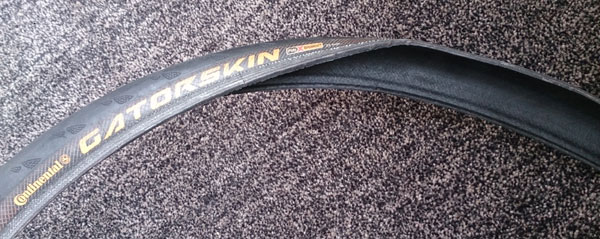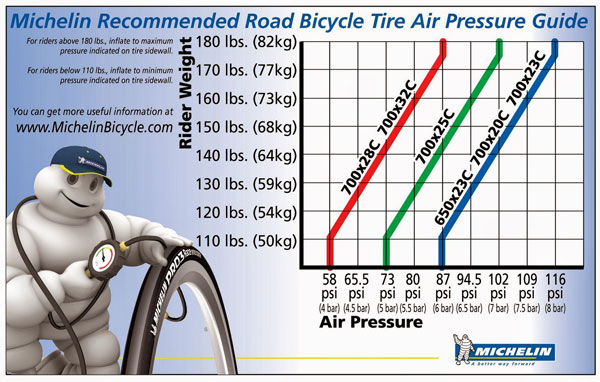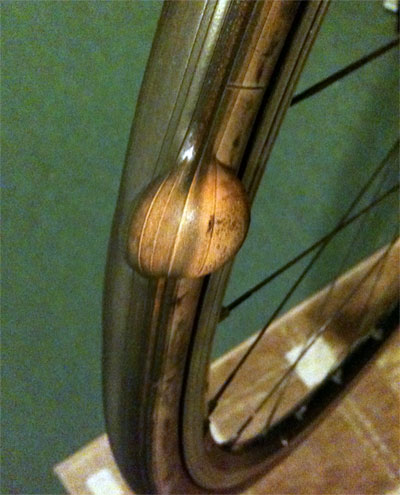Tire choice is an emotive subject for many and tends to cause long debates. After trying many tires, I can give the following recommendations.
Clincher or Tubular or Tubeless
There are three wheel/ tire types available:
Clinchers are the tires with a separate inner tube. You use tire levers to get the tire off the rim where you can pull out the inner tube to patch it. For 90% of road riders, clinchers are the best technology. If you want performance, deep section carbon rims from ENVE, ZIPP and Lightweight will provide low weight and excellent aerodynamics, but are not cheap.

A fairly standard clincher tire. This one is foldable as it has kevlar beading (the part which hooks onto the rim). The non-folding tires have wire beading. They are heavier, but about 10% cheaper - OK for training wheels.
Tubeless tires are similar to clinchers, but there is no inner tube. The seal between the tire and rim is so exact that an inner tube is not needed. Pinch flats are eliminated and lower tire pressures can be run. Rolling resistance is reduced as the friction between inner tube and outer is eliminated. You might need to put some latex milk into the tire to get a good seal, and the things can be a bugger to mount.
This appears to be the best technology for mountain bike wheels. Road riders are still using clinchers or tubulars. The Europcar team used Hutchinson tubeless for a season but switched back to tubular tires.
Tubular tires require a special kind of rim and tire. The tire is glued onto the rim, which is a time consuming and messy process. Every time you puncture you need to rip the tire off the rim and glue a new one on. A tire costs about $100, so punctures are expensive. Tubulars can be repaired, but the result is usually not quite as good as having a new tire. The data show that tubular tires - when not glued or inflated properly - can increase rolling resistance by a massive 20-30W. Never use tape to glue your tires to the rim. It increases rolling resistance and is less secure than proper glue. You must glue your tires on properly, as a rolled tubular is not a pretty sight.
Even for special race wheels, the hassle and expense of tubulars just isn't worth it unless you have a team mechanic doing the work for you. It is probably justifiable for your time trial bike if you only use the wheels for races, but otherwise, buying tubulars is something you will regret. You are better off spending on the high quality clincher rims mentioned above.
Regardless of my advice, you will look at the light weight of a tubular rim, see that all the pros ride tubulars and will decide to get them anyway!

A tubular tire showing the tread on one side and the stitching on the other side. The inner tube is stitched into the tire and the tire is glued onto the rim. Special tubular rims are required. Although it has been done , you can't safely ride a tubular glued onto a clincher rim.
Tire size
The traditional road bike wheel size is 700C, around 27 inches. Small riders may opt for 26 inch wheels, but the extra rolling resistance outweighs any gains in weight, aerodynamics and fit.
Traditionally 23mm tires are used. The recent trend is to go wider - to 25mm or even 28mm. A wider tire spreads the contact patch over a wider area, so deforms the tire wall less resulting in lower rolling resistance.
A Continental GP4000S 25mm saves about 1W over the 23mm version. This is almost nothing, and would be offset by the extra rotating mass of 20g (0.7oz) and increased aerodynamic resistance.
However, since lower tire pressures are required, the tire is more comfortable, so may be suited to rougher roads. Before fitting such tires, check that your frame has adequate clearance for larger tires.
The wide tire with the lowest rolling resistance was the Continental GP 4000S 28mm, which pulls 10W less than a Vredestain Fortezza Tri Comp 25.
Tire pressure
It is a frequently mistaken belief that higher tire pressures result in a faster ride.
The optimum pressure is lower than you might think - usually around 105psi for a 150lb (68kg) rider.
If the pressure is too high then the bike will be uncomfortable which will cause rider fatigue. The bike will also tend to bounce over road imperfections which will be slower. There is a point where rolling resistance tends to plateau, while rider discomfort increases proportionally. The manufacturer's recommended pressures should be followed. Do not pump to the maximum pressure as displayed on the tire's sidewall.
Tubular tires - around 110 - 130 psi
Clincher tires - around 100 - 110 psi
Lower weight riders should put less air in the tire. It is traditional but not necessary to drop tire pressure by 10psi in the wet.
28mm tires (wide tires) - put around 7psi less
Remember that latex tubes lose pressure at a rate of about 15psi per day, whereas butyl tubes lose less than 5psi per day. That means that latex tube users should pump tires just before the event start rather than overnight.
Also note that according to Boyles Law, with constant volume (the inner tube doesn't expand much inside the tire) but increasing temperature, the pressure will increase. I've left tubulars in a car on a hot day at 140psi and returned to find that they had burst. That was an expensive mistake that you hopefully won't repeat. Always let your tires down a bit before leaving them in a hot car.
As a side note, it isn't necessary to let down your tires before flying. Atmospheric pressure is about 1 bar (15psi), so even if you went into space, it would only drop to 0 bar. Your tires could easily cope with an increase in pressure of 1 bar, especially as it gets cold in the plane's hold (and in space).

This Michelin chart is useful to follow. You can see that for a 700x23C clincher tire and a 68kg rider (we assume a fairly standard 8kg bike) the best pressure is about 106psi.
Winter and summer tires
If you are lucky enough to live somewhere with good weather such as California, Spain or Australia, you will probably be fine to use summer racing tires all year round.
For those living in the UK or Northern states, wet and cold weather requires winter tires with high puncture resistance.
Best Winter Tires
Continental 4 Seasons - a fast tire that can cope with most winter weather. Has a protected tread and sidewall. A better choice than the Gatorskin if your roads are not awful.
Continental GatorSkin - a moderately fast tire that has excellent puncture resistance. The compound tends to be a little slippery in damp conditions.
Specialized Armadillo - Too heavy and dead for my liking, but a lot of riders swear by them. The Specialized Roubaix with full protection but the same rolling resistance as the Turbo Pro race tire is a better choice if sticking with Specialized.
Best Summer Tires
Clinchers
Continental GP4000S Hot Chili - light and very grippy tire. Good tire to race on. I have seen issues with the side walls blowing out, but this might now be solved.
Continental Attack and Force Hot Chili - The best rolling resistance than the next best tyre, equating to about 0.4mph faster or 10W. Can be good value if you find a deal (they are bought as a pair). The rear tends to wear out three time faster than the front, so buy some GP4000S to replace the rear. Otherwise these corner and race well.
Michelin
I used to be a loyal customer of Michelin, using the ProRace tires. I found that these tires tended to cut very easily, and puncture frequently. After ten years of using them, I moved to Continental, and found them to be a superior tire. This is confirmed in Tour magazine test results. The top-of-the-range Michelin Pro4 Comp had the same rolling resistance as a heavy Continental 4 Seasons Winter tire and performed only moderately in puncture resilience.
Schwalbe
I have seen tire defects - bubbling sidewalls - with Schwalbe tires. Nevertheless, they are a competent performer. The Ultremo ZX costs about 9W more than the Attack/Force whilst maintaining excellent puncture resistance and low weight.
Hutchinson
The tires tend to slash fairly easily. The rolling resistance of the Fusion 3 is high - over 20W more than the Attack/Force. The Fusion 3 tubeless tires are an interesting proposition - around 13W less rolling resistance than the standard Fusion 3.
Vittoria
Nice tires, and a traditional choice of the 60s, 70s and 80s, but times have moved on. The tires puncture too easily, rolling resistance and weight is only average. The Corsa CX is still a beautiful and supple tire to use.
Tubulars
Continental Competition - very popular tire in the pro peloton, including among teams who do not have a tire sponsor. The pros tend to use the Ltd version with latex inner tube, which is not available to the public.
Vittoria Corsa CX - a supple and delightful tire but prone to punctures. The technology isn't up to German standards.
FMB, A Dugast, and Veloflex tubulars are in use by the pro peloton for the cobbled classics.
You can buy the tires direct from the websites for around EURO 100 per tire.
Tyres for use in the wet
Tires that grip exceptionally well in wet conditions tend to have high rolling resistance.
The best tire for wet weather grip is the Schwalbe Ultremo Aqua which is made with a very sticky compound. As a result it has high rolling resistance - around 30W more than Continental Attack/Force. The Specialized Roubaix performs well in the wet, and has very reasonable rolling resistance, around 10W more than Attack/Force. Avoid the Vittoria Diamante pro as it slips unexpectedly.
Turbo Tires
It is worth getting a special tire (and wheel) for your turbo as those resistance rollers will square off your normal road tires quickly.
I've tried the Orange Continental tires - but the sidewall failed after 2 years' use (the tread hadn't even worn). The Blue Schwalbe tire became lumpy after 6 months' use. The Red Vittoria has so far proved to be the best on the turbo.

This Continental Turbo Tyre developed a hernia after about 400 hours of riding. You can see that the tread isn't worn but the tire wall has bulged. Bit of a disappointment.
Conclusion
The best overall tire for wet and dry riding is the Continental Attack/Force and GP4000S. These tires have low rolling resistance, light weight, good puncture resistance and good grip in the wet.
For tubulars, a recommendation goes to the Continental Competition, although try the wider 25C version for a little more comfort than the 22C.
I don't work for Continental, but after using all these brands over the years, they have proved to be simply the best road bike tire.
Links
